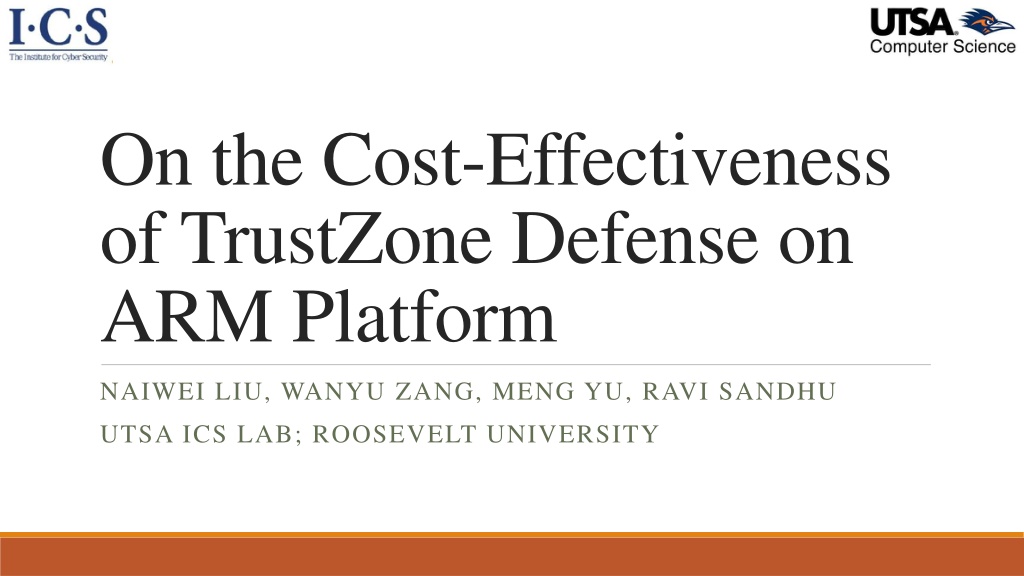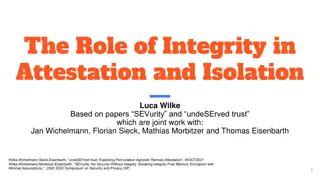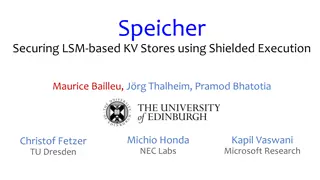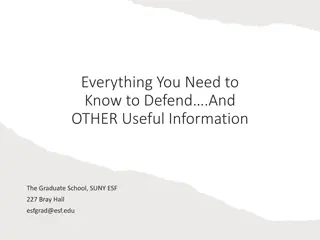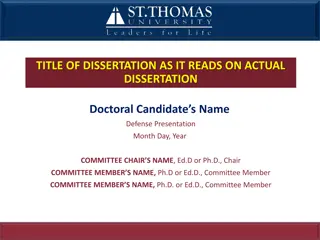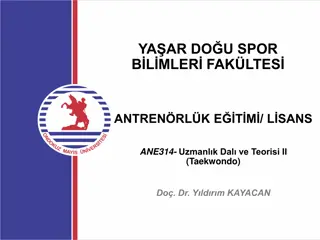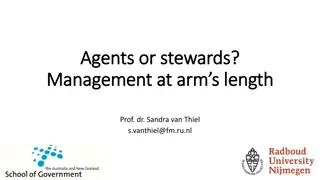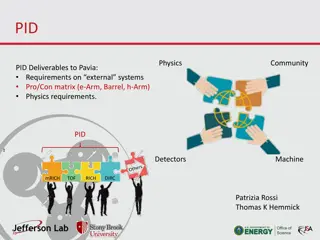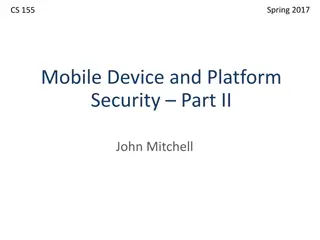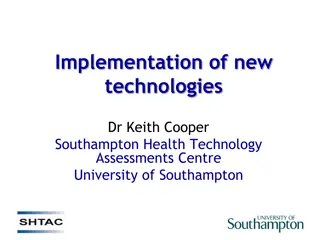Cost-Effectiveness of TrustZone Defense on ARM Platform
Recent research focuses on enhancing security on ARM platforms due to increasing security risks. This study delves into the challenges posed by cache-based security threats and discusses the development of a defense framework for ARM. The exploration involves experimental evaluations aiming to optimize security measures for ARM-based products.
Download Presentation

Please find below an Image/Link to download the presentation.
The content on the website is provided AS IS for your information and personal use only. It may not be sold, licensed, or shared on other websites without obtaining consent from the author. Download presentation by click this link. If you encounter any issues during the download, it is possible that the publisher has removed the file from their server.
E N D
Presentation Transcript
On the Cost-Effectiveness of TrustZone Defense on ARM Platform NAIWEI LIU, WANYU ZANG, MENG YU, RAVI SANDHU UTSA ICS LAB; ROOSEVELT UNIVERSITY
Contents Abstract and Introduction Related Work Cache-Based Security Threats and Attack Design and Implementations Experimental Results Evaluation Future Work Conclusion 2
Abstract and Introduction Abstract In Recent years, many research efforts had been made on secure and safe environment on ARM platform. ARM structure and chips based on ARM had been taking up a lot of number of products in the market. Security problems and potential risks had been discussed. Cache and similar design brings in trouble for security purposes. Uniqueness on ARM-based products made things even tougher to solve. What will we do? Design defense framework for ARM Evaluate by experiments Optimization 3
Abstract and Introduction Introduction Last-Level Cache (LLC) is always the target of side-channel attack. On x86 structure, it is always L3 cache that is attacked. Last-level cache side-channels are effective enough to extract user s private information. Side-channel: collecting information like performance counters, timing, power consumption, etc. And process the information to derive information about the victim. Most frequently used: access time based side-channels. 4
Abstract and Introduction Introduction (Continued) Side-channel attack based via LLC can be dangerous, even without compromising OS. Both on single OS machine and Virtual Machines (VMs) can be attacked. Typical type: FLUSH+RELOAD LLC is shared. FLUSH+RELOAD can be practical using unprivileged instructions. AES key of OpenSSL is recovered by this attack in lab test. Threats to the Internet of Things (IoT) and devices Modern TrustZone Design on ARM platform 5
Abstract and Introduction Introduction (Continued) Contributions Research on side-channel and covert-channel attack: bandwidth and effect. Investigation on Flush operations on ARM platform and overhead. Study of TrustZone technology and previous security design based on TrustZone. Investigation on critical instructions related to TrustZone operations. Test of cache flush operations: overhead and effect. Different discussion based on ARMv8-A and ARMv8-M structures. 6
Related Work Side Channel Attacks LLC based side-channel attacks: Flush+Reload, Prime+Probe Effectiveness of LLC based side-channels 7
Related Work Security Design and Protections Hardware Solution: Intel SGX, ARM TrustZone Hardware isolation for an enclave New instructions to establish, protect Call gate to enter Remote attestation Processor manufacturer is the root of the trust Prime+Probe Attack: March, 2017 Target to DRAM 8
Related Work ARM TrustZone Based on ARM Cortex-A and Cortex-M series Privileged instructions to call entry/exit Light-weighted comparing with other protection ARM helps in creating Trusted Execution Environments (TEE) Cache Problems ARM Cortex-A series ARM Cortex-M series (ARMv8-M) 9
Related Work Previous Defense Strategy against Side-Channels LLC-level Protection (memory access control) Cache enclaves (Trusted vs. Untrusted) Scheduler-based solutions Others Cache Flush against Side-Channels Benefits: easy to implement, ensure safety Problems: high overhead, not adaptive to every situation 10
Cache-Based Security Threats and Attack Overview Users memory access are not protected by TrustZone Covert Channel (Sharing resources) TrustZone Entry/Exit without Flushing cache Side-Channel (Malicious collecting access time) Flush+Reload Attack Prime+Probe Attack Malicious eavesdropping 11
Cache-Based Security Threats and Attack Side-Channel Attack Experiment Flush+Reload Attack step 0: attacker maps shared library shared memory, shared in cache step 1: attacker flushes the shared line step 2: victim loads data while performing encryption step 3: attacker reloads data fast access if the victim loaded the line Prime+Probe Attack step 0: attacker fills the cache (prime) step 1: victim evicts cache lines while performing encryption step 2: attacker probes data to determine if the set was accessed 12
Design and Implementations TrustZone-Related Instructions ARMv8-A Test Environment: ARM Juno r1 Board, with A57 and A53 chips; QEMU as testing benchmark. ARMv8-M Test Environment: ARM Development Kits with Cortex-M4 13
Design and Implementations Experiments on TrustZone Instructions ARMv8-M Our experiments on ARMv8-M are using ARM Versatile V2M-MPS2 Motherboard with an ARM Cortex- M4 chip. It offers 8Mb of single cycle SRAM, and 16Mb of PSRAM. It supports the application of different ARM Cortex-M classes, from Cortex-M0, to M3, M4, and M7. 14
Experimental Results Experiments on TrustZone Instructions ARMv8-A We use Ubuntu 16.10 as the normal world OS, with 26 processes running on background, including the workload we use for testing. We count the smc-related instructions that belongs to TrustZone- related operations, and analyze the attributions of them. Type Non-secure to Secure Test R/W Secure to Non-secure Test R/W Others (Access from Background) Percentage 2.87% 2.91% 0.01% 15
Experimental Results Experiments on TrustZone Instructions ARMv8-A With every smc-related instruction, we operate Flush on cache. 16
Experimental Results Experiments on TrustZone Instructions ARMv8-A We change the overall percentage of smc instructions and see the overhead difference. 17
Experimental Results Experiments on TrustZone Instructions Cortex-M Our experiments on ARMv8-M are using ARM Versatile V2M-MPS2 Motherboard with an ARM Cortex- M4 chip. It offers 8Mb of single cycle SRAM, and 16Mb of PSRAM. It supports the application of different ARM Cortex-M classes, from Cortex-M0, to M3, M4, and M7. 18
Experimental Results Experiments on TrustZone Instructions Cortex-M Using Testing Program as shown above. Operation Direction Cost on Average (Clock Cycles) SG Non-Secure to Secure Secure to Non- Secure 3.5 BXNS/BLX NS 5.2 19
Experimental Results Experiments on TrustZone Instructions ARMv8-M We change TrustZone entry/exit frequency by setting different parameters in inner and outer loop. The overhead can be limited to less than 5%. 20
Evaluation On the cost-effectiveness balance of defending by Flush operations Flush operations are necessary, but they cost much; We can never wipe out the risk, but can cut down bandwidth; Adaptive strategy can be used to keep the balance of performance and effectiveness; Even better on ARMv8-M chips. 21
Evaluation On TrustZone related instructions Most of the apps and users are not making use of TrustZone features; On IoT devices, TrustZone is not costing much resources; It is possible to move some of the hardware/software security design into TrustZone surface; Cortex-M series chips perform better than Cortex-A series chips. On Cortex-A series chips or x86 chips, cache flush operations are just some instructions with privileges. However, the case are different on ARMv8-M. The allocation of a memory address to a cache address is defined by the designers of the applications. Because of the special structure of ARMv8-M, the cache Flush operations are sets of DSB (Data Synchronization Barrier) operations, with address-related instructions. 22
Future Work Implementations and Experiments Design and implement a defense framework based on ARMv8-M. Test the performance of defense framework using some benchmarks, and optimize the framework to good effectiveness and lower overhead. Port defense framework to new ARMv8-M boards: M23 and M33 series chips. Theory Work Study adaptive control method in theory to match the experimental results, and predict the optimal solution of best adaptive control in defense. Investigate entropy theory based on experimental results, predictions and related theory. Discuss performance of implemented defense framework in theory, and try to have theoretical conclusion on defense against cache-based attack. 23
Conclusion Cache-based attack are new focal point on security design, with risks of leaking information through side-channel and covert channels. Flushing cache is effective to cut down the risk, but with high performance overhead, and sometimes not affordable. On IoT devices, the performance of connecting with TrustZone can be better, which brings the possibility to making use of TrustZone. 24
Thank you! Naiwei Liu, UTSA ICS Lab, Naiwei.liu@utsa.edu Ravi Sandhu, UTSA ICS Lab, ravi.sandhu@utsa.edu Meng Yu, Roosevelt University, myu04@Roosevelt.edu 25
